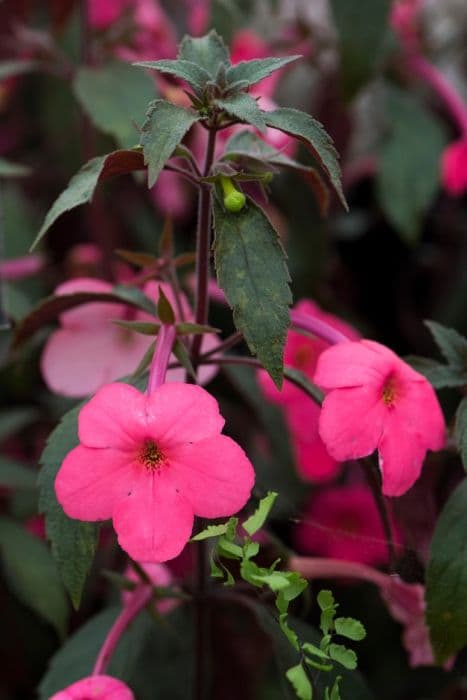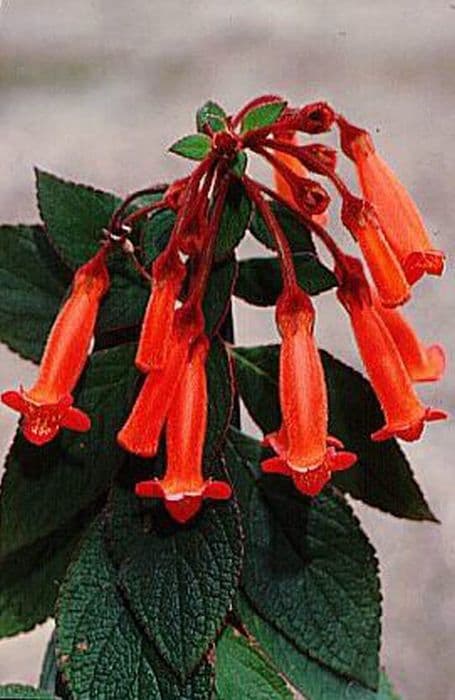Cape Primrose Streptocarpus 'Alana'

ABOUT
Streptocarpus 'Alana' is a flowering houseplant known for its attractive foliage and blooms. This variety typically has velvety leaves that are long and oval-shaped, with a deep green color and sometimes a slightly crinkled texture. The leaves form a basal rosette, emerging from the base of the plant and often arching gracefully. The flowers of Streptocarpus 'Alana' are its most striking feature. They emerge on slender, upright stalks that rise above the foliage. Each stalk can carry multiple blooms that are trumpet-shaped. The flowers of 'Alana' can vary in color, often displaying shades of purple, blue, or pink, with intricate patterns or markings in contrasting hues that may include white or yellow. These patterns can be speckles, stripes, or a throat of a different color, adding to the plant's ornamental charm. The overall appearance of Streptocarpus 'Alana' is lush and vibrant, making it a popular choice for adding a splash of color to indoor spaces.
About this plant
 Names
NamesFamily
Gesneriaceae
Synonyms
Cape Primrose, African Violet Cousin
Common names
Streptocarpus 'Alana'.
 Toxicity
ToxicityTo humans
The common name for Streptocarpus 'Alana' is Cape Primrose. Cape Primrose is not known to be toxic to humans. However, ingesting any part of non-edible plants should generally be avoided as it might cause mild stomach upset or an allergic reaction in some individuals.
To pets
The common name for Streptocarpus 'Alana' is Cape Primrose. Cape Primrose is not considered toxic to pets such as cats and dogs. However, consumption of plant material, especially in significant quantities, could lead to gastrointestinal upset, including vomiting and diarrhea. It is always best to prevent pets from eating houseplants and to monitor for any signs of distress if they do ingest any plant material.
 Characteristics
CharacteristicsLife cycle
Perennials
Foliage type
Evergreen
Color of leaves
Green
Flower color
Varies
Height
1 foot (30 cm)
Spread
1 foot (30 cm)
Plant type
Herb
Hardiness zones
10
Native area
Africa
Benefits
 General Benefits
General Benefits- Decorative Appeal: Streptocarpus 'Alana', commonly known as Cape Primrose, features attractive, velvety foliage and vibrant flowers that enhance the aesthetic of indoor spaces.
- Low Maintenance: Cape Primrose does not require frequent watering or feeding, making it an ideal choice for beginners or those with busy lifestyles.
- Compact Growth: With its compact size, this plant is suitable for smaller areas such as desktops, shelves, or windowsills.
- Long Blooming Period: Cape Primrose typically has a lengthy blooming period, providing color and interest for much of the year.
- Variety of Colors: The 'Alana' variety can come in different shades, offering versatility in color choices for the home decorator.
- Positive Psychological Effects: As with many houseplants, the presence of Streptocarpus 'Alana' can enhance mood and provide a sense of well-being through its natural beauty.
 Medical Properties
Medical PropertiesThis plant is not used for medical purposes.
 Air-purifying Qualities
Air-purifying QualitiesThis plant is not specifically known for air purifying qualities.
 Other Uses
Other Uses- Photography Subjects: Streptocarpus, with their striking flowers, make excellent subjects for macro photography, helping photographers to practice their skills and create beautiful portfolios.
- Educational Tools: Biology teachers can use Streptocarpus plants to demonstrate the plant lifecycle, pollination, and the basics of horticulture to students.
- Art Inspiration: The intricate patterns and vivid colors of Streptocarpus flowers can serve as inspiration for artists and designers, influencing everything from watercolor paintings to fabric design.
- Science Experiments: These plants can be used in scientific studies relating to plant growth under various light spectrums or the efficacy of different fertilizers.
- Craft Materials: Pressed Streptocarpus flowers can be used to make unique bookmarks, greeting cards, or in scrapbooking, preserving the beauty of the blooms in crafts.
- Feng Shui Element: Some practitioners use Streptocarpus in Feng Shui to invite positive energy into the home due to their lush and vibrant presence.
- Botanical Illustration: Artists specializing in botanical illustration may use Streptocarpus as subjects to create detailed representations for academic or decorative purposes.
- Garden Design: Streptocarpus can be used to teach elements of garden design, helping budding landscapers learn about color composition and spatial planning.
- Color Dye Source: The pigments from the flowers could potentially be used to create natural dyes for textiles or art projects, albeit not commonly practiced.
- Event Decor: Potted Streptocarpus plants or cut flowers may be used in event decorations such as weddings or parties for an elegant and colorful touch.
Interesting Facts
 Feng Shui
Feng ShuiThe Cape Primrose is not used in Feng Shui practice.
 Zodiac Sign Compitability
Zodiac Sign CompitabilityThe Cape Primrose is not used in astrology practice.
 Plant Symbolism
Plant Symbolism- Perseverance: Streptocarpus, commonly known as Cape Primrose, often symbolizes perseverance because it can thrive with minimal care and continue to bloom in less than ideal conditions, reflecting the trait of persisting despite challenges.
- Endurance: The Cape Primrose’s ability to bloom throughout the year, even in low light conditions, often makes it a symbol for endurance and the ability to withstand hardships over time.
- Hope: With its bright and cheerful flowers, the Cape Primrose is sometimes associated with hope, representing optimism and looking toward the future with a positive outlook.
- Vitality: The plant’s vigorous growth and the vibrancy of its flowers can symbolize vitality, channeling the energy and essence of life.
 Water
WaterCape Primrose should be watered when the top inch of soil feels dry to the touch, typically once every 5 to 7 days, depending on environmental conditions. Use room temperature water to avoid shocking the plant; 8 to 16 ounces should be sufficient for a standard 6-inch pot, thoroughly moistening the soil. It's key to water the soil directly and avoid wetting the leaves to prevent fungal diseases. Ensure the pot has good drainage to avoid waterlogging, which can lead to root rot.
 Light
LightCape Primrose thrives in bright, indirect light, making an east-facing windowsill an ideal spot for it. Direct sunlight, especially during the hottest parts of the day, should be avoided as it can burn the leaves. The plant also does well under fluorescent lights, so it's suitable for office environments where natural light may be limited.
 Temperature
TemperatureCape Primrose prefers a temperature range between 60°F and 75°F for optimal growth. The plant can withstand temperatures as low as 50°F but will start to suffer if exposed to temperatures below that. It's best to avoid placing your Cape Primrose in areas with drafts or sudden temperature changes, which can stress the plant.
 Pruning
PruningPruning Cape Primrose is mainly done to remove faded or dead flowers and leaves to encourage new growth and more blooms. It's best to prune the plant periodically throughout the blooming season, which can be almost year-round in optimal conditions. Pinching back the tips of the stems can also promote a bushier plant. The start of the growing season in spring is an ideal time to do heavier pruning to shape the plant and clean out any winter damage.
 Cleaning
CleaningAs needed
 Soil
SoilThe best soil mix for Cape Primrose (Streptocarpus 'Alana') is a well-draining, porous mix such as a combination of peat, perlite, and vermiculite. A preferable soil pH would be slightly acidic to neutral, ranging from 6.0 to 7.0.
 Repotting
RepottingCape Primrose should be repotted once a year or when it outgrows its current pot, which is often indicated by roots growing through the drainage hole.
 Humidity & Misting
Humidity & MistingCape Primrose thrives best in moderate to high humidity conditions, ideally around 50-60% relative humidity.
 Suitable locations
Suitable locationsIndoor
Place in bright, indirect light and avoid dry air.
Outdoor
Shelter from direct sun; mist leaves in dry climates.
Hardiness zone
10-11 USDA
 Life cycle
Life cycleThe life cycle of Streptocarpus 'Alana', also known as Cape Primrose, begins with seed germination, where light and warmth prompt the seeds to develop into tiny seedlings. These seedlings grow into rosettes of leaves, a vegetative stage where they produce large, textured leaves that form a basal rosette. During its blooming period, usually in spring or summer but potentially year-round indoors, the plant produces colorful trumpet-shaped flowers on slender stalks that arise from the base of the leaves. After pollination, the flowers will fade and seed capsules may form, completing the reproductive stage. If conditions are favorable, the plant can enter a period of dormancy, often in response to cooler temperatures or reduced light, during which growth slows. With proper care, Streptocarpus 'Alana' can live for several years, producing new leaves and flowers each season.
 Propogation
PropogationPropogation time
Spring-Early Summer
Streptocarpus 'Alana', commonly known as Cape Primrose, is best propagated during its active growth period, which is generally in the spring and summer. The most popular method of propagation for Cape Primrose is leaf cuttings. A healthy leaf is selected and a clean cut is made across the leaf, creating several sections each with some vein and leaf material. Each section is then inserted upright into a well-draining potting mix, ensuring that the cut edge is buried just slightly under the soil surface. The container is kept in a warm, well-lit area but not in direct sunlight, and the soil is kept moist but not waterlogged. Roots and new shoots usually develop in a few weeks, and once these are well established, they can be potted on as individual plants.









